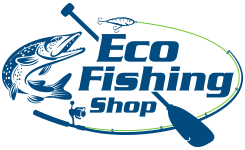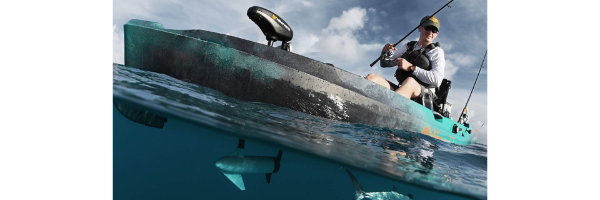A Beginner's Guide to Fishing Kayaks
Chances are, you’re reading this Eco Fishing Shop blog because you stumbled across fishing kayaks. Whether it was on Instagram, Facebook, TikTok, or through your own research, your interest is growing. They are beautiful, and for anglers, a must-have addition to your fishing arsenal. But, if you are like me and you are a newcomer to fishing kayaks, there is a lot to learn and consider.
Do you have to be an angler to enjoy them? How big are they? How do you transport them? What are the different propulsion systems? Do you need kayaking experience? How do you mount fish finders? What are some of the unforeseen challenges to be aware of as a first-time buyer?
Having just gone through the research and purchasing process, let’s discuss some of the questions you may have as you consider your fishing kayak.
Do You Need Kayaking Experience?
My kayaking experience prior to purchasing my Vahunks Pike Fin Drive was very limited. I had only used a few traditional sit-in kayaks a few times in my life. Stepping up in weight class by purchasing a fishing kayak was intimidating.
Despite the larger size, I’ve found the fishing kayak easier to paddle and maneuver than a traditional kayak. The added bonus? It feels super stable. If you lack kayaking experience, plan on taking your kayak out on smaller waters with little to no chop to get comfortable and familiar with your setup before tackling larger waters.
Do You Need to be an Angler to Enjoy a Fishing Kayak?
Easy answer. No. Each kayak at Eco Fishing Shop can be customized in many different ways. If you are an angler, you can add fish finders, rod holders, coolers, live-wells, trolling motors, and so much more to customize your fishing kayak for angling.
If you are someone who enjoys being on the water and you plan to use it more for adventuring or casual trips, a fishing kayak is still a good choice. They provide ample storage space, stability, multiple propulsion types and accessory rails that can be used for more than fishing accessories.
How Big Are They?
Like anything else, they come in many different lengths, widths, weights and hull shapes. Consider these dimensions when making your purchase. In the water, our fishing kayaks are built to move easily and with as little effort as possible. However, even if you are a world-class athlete, fishing kayaks can be difficult to move around when OUT of the water.
Have a plan on how you will move and store your kayak when it is not in the water. Think about how you will get your kayak to and from the water. Transport carts make this process very simple as you only have to lift one end and can roll to the water. Many carts can be stowed on your kayak while you are on the water.
How Do I Transport a Fishing Kayak?
Newcomers might find this the most difficult part of their research and application once they get their kayaks. Know your plan before your kayak(s) arrive. Consider your vehicle type, vehicle height, towing capability, and the max number of kayaks you will be transporting.
As we discussed above, fishing kayaks can be big and awkward to lift. If you have a car rack and plan to use J-hook-style kayak holders, consider your vehicle height and your own physical limitations. If you have a taller vehicle like a van, SUV, or truck, it will take some effort, and most likely two people, to get your fishing kayak in a J-hook roof rack.
![]()

If you are a solo kayaker, you can purchase a roof rack accessory for transporting your kayak flat. Many of our customers transport their kayaks this way, whether it is on a car roof or bigger vehicle roof. Loading on to this style of roof rack can be much easier.
Pickup truck owners planning to transport only one kayak can buy hitch extenders. Load your kayak in your truck bed and the back end of your kayak sits on the hitch extender arm. It is an easy solution for solo kayakers with a pickup truck.
![]()

If you think you will have trouble loading on a roof and you don’t own a truck, a trailer is the best option. While your initial cost will be higher, the ease of getting your kayaks to and from the water will save you time, effort, and frustration which leads to more time on the water. Many kayak-specific trailers are water rated so they can be backed in at boat launches. Because kayak trailers tend to be light, most vehicles with a hitch can pull them without issue.
There are many options for transporting your kayaks. Cost and capability are things to consider. Do your research and be aware of your possible barriers. I started with J-hooks on a minivan and transitioned to a trailer once I realized it would be a barrier for my wife and I to use consistently.
What are the Different Propulsion Systems?
Paddle, pedal and power. We wrote an in-depth breakdown of the three systems, here.
Pedal Drive System
Pedal drives allow anglers to propel the kayak with a pedaling system much like a bike. Pedal drives require full circular revolutions just like a bike that spin the prop. Most pedal drives allow for forward and reverse by pedaling in either direction. This can offer a big advantage when in tight spots.
Fin Drive System
Fin drives, like pedal drives, are propelled using pedals. Two fins attached to the pedal system flap sideways to propel the kayak. Fin drives only require minimal pedaling forwards and backwards, not circular revolutions like the pedal drive and can be put flush against the bottom of the hull. Fin drives are a good option for shallow water and for operators who may have limited joint mobility. Not all fin drives are capable of reverse movement.
Powered Drive System
Just like a fishing boat fitted with a trolling motor, a propeller-driven fishing kayak is fitted with a small 12-volt motor. This approach to kayak propulsion is both great for quickly covering long distances and also keeping quiet while closing in on a prime fishing spot. Powered kayaks require a battery.
How Do Fish Finders and Accessory Tracks Work?
Most fishing kayaks come with an accessory track where you can mount an almost limitless amount of accessories. Fish finders, camera mounts, extra rod holders, paddle leashes, stand-up bars, and so much more can be added to your kayak using the accessory tracks. A helpful hint is to know what type of accessory you are buying and to make sure it has the piece that goes in your track.
For example, if you are buying the Railblaza R-lock-S to mount a Garmin Fish Finder, you would need the Railblaza MiniPort rail piece as well. In this scenario, you mount the Miniport on your accessory track, then the R-lock-S to the MiniPort.
![]()

Having a fish finder is essential when targeting certain species in specific water types. Once you have found your fishing kayak, research how you will mount and power your fish finder and transducer. Some fishing kayaks come ready with thru-hull wiring ports already built into the kayak. Some may require adding your own. Others, like the Vanhunks Pike I am in, have a transducer plate and you run the transducer wire through your scupper hole.
There are options like the YakAttack battery block and transducer arm. If modding a kayak is not a good fit for you, you could buy something like the YakAttack battery kit and power it that way – but be aware that even though these batteries are water-resistant, they are not all waterproof. *No matter the fish finder and transducer, you will need a power source.*
Additional Considerations
Through every step of the process, patience is needed. From placing your order and waiting on shipping to allowing yourself grace when you get your kayaks. If this is your first time, chances are you will not be ready to unwrap your kayak(s) and hit the water on the same day. Give yourself some grace and be mindful there is a learning curve to preparing your kayak(s) for the water and transport.
Don’t hesitate to seek guidance. Eco Fishing Shop wants to be more than just the company you buy your kayak from. We want to be your all-encompassing support. Our public forum, the Kayak Anglers Resource, was started to give members a place to start their own conversations and answer other kayakers and anglers’ questions using their experiences. We also launched our podcast of the same name, Hooked – The Kayak Anglers Resource, to share additional stories and tips along your journey.
And of course, you can always talk to our customer service and sales staff who are more than willing to walk you through any questions you may have – sales@ecofishing.com, 1-844-987-5777.













